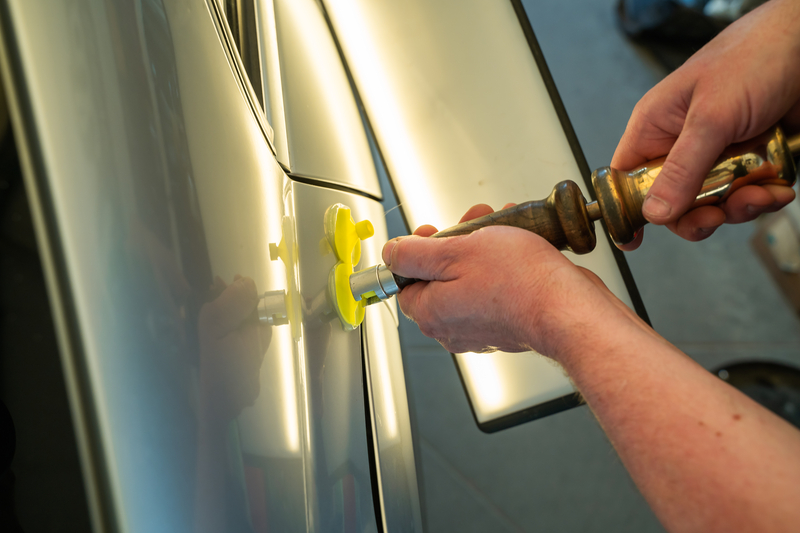Dents happen. A rogue shopping cart, a minor fender bender, or a mystery mark left in a parking lot—these small imperfections on your vehicle’s body can be frustrating. With a quick online search, many car owners discover an enticing option: DIY dent removal kits. They’re marketed as affordable, easy-to-use tools that can save you a trip to the body shop. But before you grab one off the shelf or click “add to cart,” let’s dive into what these kits actually do—and why you might want to think twice.
The Appeal of DIY Dent Repair
DIY dent removal kits promise a quick fix. For under $50, they claim to reverse dents without damaging paint, requiring minimal skill, and in just minutes. Sounds perfect, right? Add to that the endless YouTube tutorials and TikTok videos showing flawless “before and after” shots, and it’s easy to see why these kits have exploded in popularity.
Unfortunately, what those videos don’t show are the dents that get worse—or the cars that end up in the body shop anyway.
How DIY Dent Removal Kits Work
Most dent removal kits fall into a few categories:
- Glue pullers: Use hot glue and a pulling tab to yank out the dent.
- Suction tools: Attach to the dent and use vacuum or hand pressure to pull.
- Heat/cold methods: Involve heating the dent with a hair dryer and quickly cooling it with compressed air.
These kits might work on extremely shallow dents, especially on flexible metal surfaces. But most dents are not that simple.
What the Kits Don’t Tell You
Even if you follow instructions to the letter, you’re working blind. DIY kits don’t account for:
- Metal memory: Modern car panels are engineered to return to their original shape when worked correctly. That requires understanding the metal’s behavior—something most kits can’t offer.
- Paint integrity: One wrong move with a glue puller can pull off your clear coat or paint layer.
- Creases or sharp dents: These often can’t be fixed without accessing the back side of the panel—something no suction cup can do.
- Aluminum or high-strength steel: Some materials require specialized tools and techniques to repair properly.
And here’s the real kicker: once you’ve stretched or creased the metal, even a professional may not be able to restore it fully.
The Real Risks of DIY Dent Repairs
Let’s break it down:
1. Paint Damage
A dent might seem superficial, but it often affects the paint. Using glue or heat tools can peel, blister, or crack your paint—making the damage worse and opening the door to rust.
2. Rust Formation
If your clear coat or paint layer is compromised, water and salt can reach the bare metal underneath. Rust doesn’t just ruin your car’s appearance—it eats away at the body.
3. Resale Value
Car dealerships and savvy buyers can spot a poor repair job instantly. Amateur dent removal can lower your car’s value and raise questions about how well the rest of the vehicle was maintained.
4. Structural or Safety Concerns
Some dents occur near crumple zones, sensors, or safety systems. Improper repairs can interfere with the vehicle’s integrity in a future accident.
Why Professional Repair Matters
Professional Paintless Dent Repair (PDR) technicians use specialized tools to gently massage dents from the inside of the panel. They understand how metal responds, how to avoid paint damage, and how to maintain the original shape without compromising the panel.
Benefits of professional dent repair include:
- No risk to the paint or structural integrity
- Higher-quality, nearly invisible results
- Warranties or guarantees on work
- Repairs that align with insurance and resale expectations
In many cases, PDR is faster and more affordable than people expect—and it doesn’t come with the risks of DIY.
When to Absolutely Skip DIY Kits
There are situations where you should always leave it to the pros:
- Dents larger than a quarter
- Dents on a body line or sharp crease
- Dents near edges or door panels
- Dents with visible paint damage
- Vehicles made with aluminum or exotic metals
Even small dents can have complex underlying issues.
Saving Now Could Cost More Later
We get it—saving money matters. But saving $100 today could lead to a $500 paint repair or panel replacement tomorrow. If you botch the job, a body shop has to undo the damage before they can even start the repair.
Instead of taking a gamble with a kit and a YouTube tutorial, you’re better off investing in a professional evaluation. Most reputable shops offer free estimates and can tell you whether PDR is a good fit.
If you’ve noticed a dent or ding on your vehicle, don’t risk making it worse with a DIY kit. Reach out to a trusted local shop like Atomize Collision & Customs. Our expert technicians will assess the damage, walk you through your options, and help restore your vehicle the right way—with precision, care, and lasting results.
Contact us today to schedule your free estimate and experience the difference of professional-grade auto body work.

